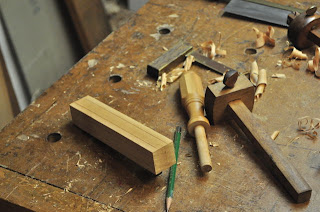These are not hard to make and it's a great way to use up small wood scraps and cutoffs. What's shown here is for the turning saw, but the idea is easily adapted for edge tools with the addition of a ferrule. I've started with well seasoned pear wood, one of my favorites, especially for turning. The blank is squared with a jack plane and the flats laid out with a marking gauge.
A sharp low angle block plane is used to cut the "flats". Measure to make sure that the flat truncation equals the remaining portion of the squared blank. It's ready to go to the lathe when all four truncations have been made.
The lathe work is fairly straight forward, and can be varied to a particular hand size or ferrule for chisels or gouges. Tung oil is a great finish for pear. It can be applied when the stock is still on the lathe using the heat build up from friction to increase absorption and cure the drying oil. My next post will show the construction of the turning saw. Thanks for your interest.





No comments:
Post a Comment